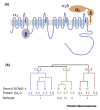The Emerging Neurobiology of Bipolar Disorder
- PMID: 29169634
- PMCID: PMC5755726
- DOI: 10.1016/j.tins.2017.10.006
The Emerging Neurobiology of Bipolar Disorder
Abstract
Bipolar disorder (BD) is a leading cause of global disability. Its biological basis is unknown, and its treatment unsatisfactory. Here, we review two recent areas of progress. First, the discovery of risk genes and their implications, with a focus on voltage-gated calcium channels as part of the disease process and as a drug target. Second, facilitated by new technologies, it is increasingly apparent that the bipolar phenotype is more complex and nuanced than simply one of recurring manic and depressive episodes. One such feature is persistent mood instability, and efforts are underway to understand its mechanisms and its therapeutic potential. BD illustrates how psychiatry is being transformed by contemporary neuroscience, genomics, and digital approaches.
Keywords: L-type calcium channels; digital phenotyping; genomics; mood disorder; mood instability; therapeutics.
Copyright © 2017 The Authors. Published by Elsevier Ltd.. All rights reserved.
Figures


References
-
- Craddock N., Sklar P. Genetics of bipolar disorder. Lancet. 2013;381:1654–1662. - PubMed
-
- Wise T. Voxel-based meta-analytical evidence of structural disconnectivity in major depression and bipolar disorder. Biol. Psychiatry. 2016;79:293–302. - PubMed
-
- Brown N.C. An updated meta-analysis of oxidative stress markers in bipolar disorder. Psychiatry Res. 2014;218:61–68. - PubMed
Publication types
MeSH terms
Grants and funding
LinkOut - more resources
Full Text Sources
Other Literature Sources
Medical

